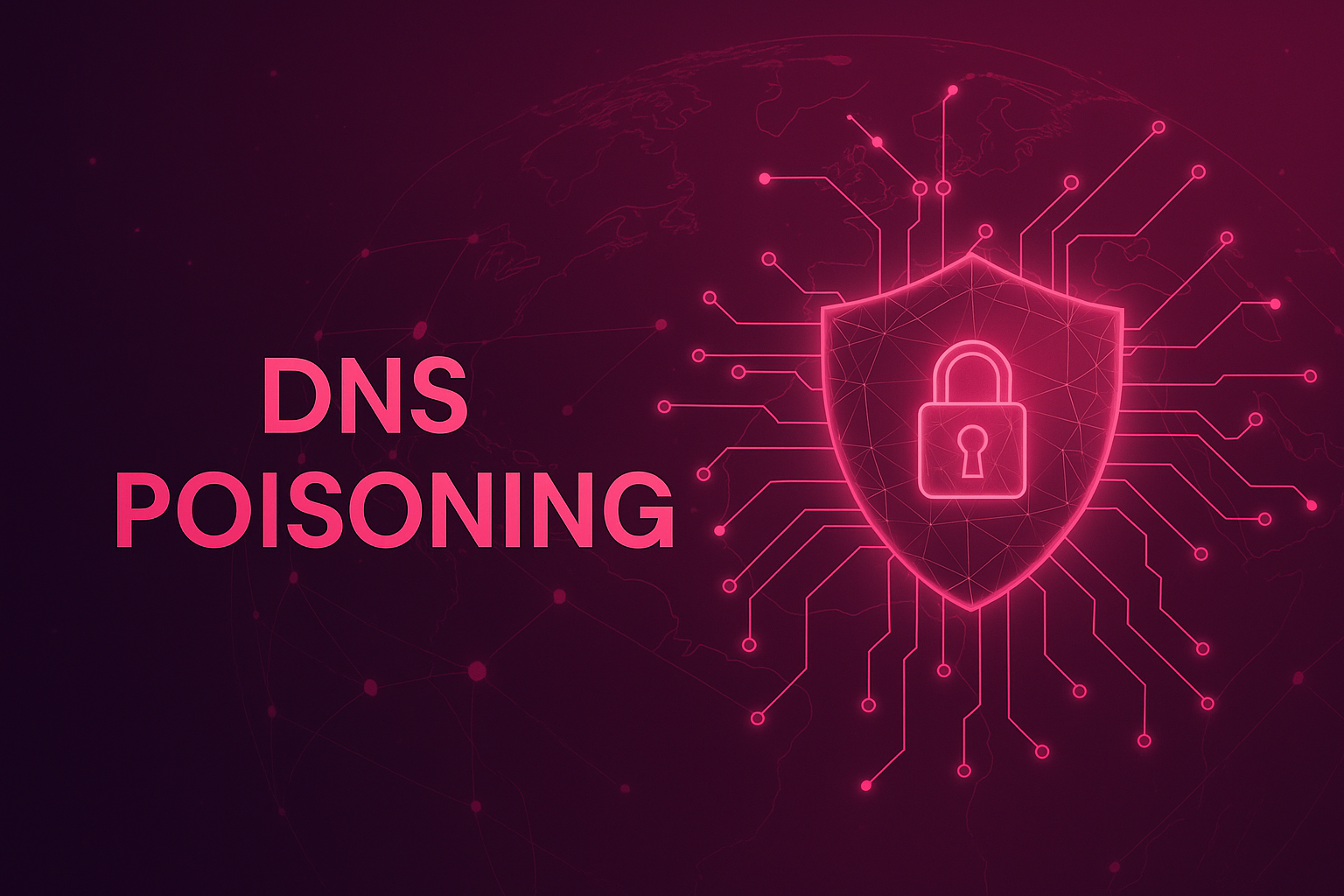Let’s start simple. DNS poisoning—also called DNS cache poisoning—is when an attacker corrupts the DNS resolver’s cache, causing it to return fake IP addresses for legitimate domains. It’s not just clever—it’s dangerous. Suddenly, users think they’re going to yourbank.com, but they’re actually hitting a rogue IP controlled by the attacker. That’s how credentials leak, malware spreads, and data vanishes.
So, what is DNS cache poisoning attack in practical terms? It’s an exploit that rewires the internet’s phone book so your browser dials the wrong number. And once the poison is in the cache? Every device that queries that resolver gets the fake answer—until it expires.
How DNS Poisoning Works
At its core, DNS poisoning involves injecting forged data into a DNS resolver’s cache. The goal? Trick the resolver into associating a domain name (like bank.com) with a malicious IP address.
Here’s how it typically plays out:
- The attacker sends a query to a vulnerable DNS resolver, often via a spoofed client.
- Simultaneously, the attacker floods the resolver with fake responses crafted to look like they came from the authoritative DNS server.
- If the attacker’s fake response matches the resolver’s query (based on transaction ID, port, and source), it gets accepted.
- The resolver caches this forged response.
- Any user querying that domain during the TTL (Time to Live) window is redirected to the attacker’s chosen IP.
This technique works especially well when resolvers:
- Accept unauthenticated responses
- Don’t use source port randomization
- Don’t implement DNSSEC
And the worst part? The poisoned entry remains until it expires—or until administrators manually intervene.
Advanced attackers may also chain this with phishing, malware delivery, or command-and-control callbacks, often using subdomains to bypass detection.
Which Is a Characteristic of a DNS Poisoning Attack?
A defining characteristic of a DNS poisoning attack is its stealth and persistence. Once the attacker successfully injects a fake DNS entry into a resolver’s cache, it behaves like any valid DNS response, making it nearly invisible to the average user.
Key indicators include:
- Clients resolve legitimate domains to unauthorized or external IPs, often controlled by attackers.
- Redirection to malicious websites or phishing portals, where users may unknowingly enter credentials or download malware.
- Persistence of the poisoned record until the resolver’s TTL expires or an admin flushes the cache—this is where the DNS resource record becomes crucial, as it indicates how long any DNS poisoning could last.
- Infiltration of command-and-control channels, where malware uses forged DNS entries to call home or receive further instructions.
The most dangerous aspect? Poisoned responses come from a trusted resolver—so the user never suspects anything is wrong.
What Is DNS Cache Poisoning vs. DNS Spoofing?
These two concepts are often bundled together, but they’re not the same thing.
- DNS Spoofing is the tactic—an attacker forges a DNS reply to trick a system into accepting a rogue answer.
- DNS Cache Poisoning is the outcome—a compromised DNS cache now feeds incorrect data to multiple clients.
Think of spoofing as the active attack, and cache poisoning as the residual damage that lingers. A single successful spoofing attempt can poison an entire organization’s cache, meaning every subsequent DNS query for that domain resolves to a malicious IP.
Understanding this distinction is essential when crafting detection and prevention strategies.
How to Detect DNS Poisoning
Early detection is critical to minimize the impact of a poisoning attack. Here’s how to detect DNS poisoning or how to detect DNS cache poisoning effectively:
- Monitor for anomalies in DNS traffic. If users start resolving well-known internal or external domains to unexpected IPs, it’s a red flag.
- Log DNS queries and responses by segment, so you can detect unusual resolution paths within isolated environments. For example, an HR laptop resolving corp-auth.local to a public IP.
- Use SIEM integrations to track changes in resolution behavior, including TTL mismatches, unauthorized upstream responses, or sudden spikes in queries for high-value domains.
- Compare local DNS results to known-safe external resolvers (like Cloudflare’s 1.1.1.1 or Google’s 8.8.8.8) using dig, nslookup, or DNS inspection tools.
- Deploy DNS response integrity tools that validate origin authenticity, response format, and record signatures.
- Check for inconsistencies in DNS TTL values—suspiciously long or short TTLs may suggest poisoning attempts.
- Inspect lateral DNS query behavior, such as workstations querying resources outside their assigned zones.
DNS poisoning often goes unnoticed because it doesn’t break connectivity—it hijacks it. That’s what makes detection so important.
How to Fix DNS Poisoning
Once you identify a poisoned resolver, time is critical. Here’s how to fix DNS poisoning or how to fix DNS cache poisoning fast:
- Flush the DNS cache on the affected resolver using OS-specific or software-specific commands (e.g., rndc flush for BIND, Clear-DnsServerCache in PowerShell).
- Restart DNS-related services to clear memory-resident poison entries.
- Audit client caches and prompt device reboots or manual cache clears (e.g., ipconfig /flushdns) if needed.
- Inspect DNS configuration: ensure upstream DNS servers are trusted, authenticated, and preferably encrypted (DoH/DoT).
- Enable DNSSEC validation on your resolvers. This ensures future DNS responses are cryptographically signed and verified.
- Update firewall and microsegmentation rules to block traffic to known malicious IPs and ensure endpoints only query internal DNS servers.
- Monitor resolver behavior post-cleanup to confirm that normal resolution patterns resume.
- Log and audit all resolver queries temporarily to detect any reattempts or residual anomalies.
More importantly, analyze how the poisoning occurred. Was it due to weak DNS software, lack of upstream authentication, or a misconfigured firewall? Fixing the root cause is just as vital as flushing the cache.
What Is a DNS Resource Record?
A DNS resource record (RR) is a data structure used to store information in the DNS. Each record includes details like domain name, record type (A, AAAA, CNAME, etc.), TTL (time-to-live), and value. The TTL field is particularly relevant for DNS poisoning, as it determines how long any DNS poisoning could last—if an attacker successfully injects a record with a long TTL, the poisoned data can persist for hours or even days.
Common DNS record types relevant to poisoning:
- A/AAAA records – IP address mappings that can be poisoned to redirect traffic.
- NS records – Delegation records that, if spoofed, can redirect entire zones.
- CNAME records – Aliases that can be used to obscure redirections.
Securing these records using DNSSEC ensures they’re signed and validated before acceptance.
The Role of DNS in Broader Security Context
DNS is more than a lookup tool—it’s a critical control plane for application access, user behavior, and even malware communications. Poisoning it means undermining the very structure of trust in your infrastructure.
Here’s how DNS poisoning can undermine even hardened environments:
- Redirecting authentication portals to rogue sites.
- Hijacking update mechanisms to distribute malware.
- Subverting email SPF/DKIM/DMARC validation by poisoning MX or TXT records.
Organizations relying on MFT, VDI, or SASE must treat DNS integrity as a foundational security pillar.
Why Microsegmentation Alone Won’t Stop Poisoning—but Still Matters
Microsegmentation doesn’t validate DNS responses—but it reduces the damage. Segmentation:
- Limits which DNS servers endpoints can query.
- Contains poisoned zones to one segment.
- Blocks lateral movement if an endpoint resolves a fake address.
- Adds logging context to detect DNS anomalies per segment.
When used with DNSSEC, identity-aware microsegmentation ensures that even if a fake IP gets through, it can’t be used to move laterally or reach other zones.
Final Word: Layered DNS Defense
Preventing DNS poisoning requires layered defense:
- DNS Integrity: DNSSEC, authenticated upstreams, signed zones.
- Segmentation: Agent-based microsegmentation, Layer 3 ACLs.
- Detection: SIEM rules, DNS anomaly detection, logging TTL and response origin.
- Response: Fast cache flushing, resolver hardening, upstream audits.
If you treat DNS as a soft side-channel—you’ll get burned. If you treat it as a core attack vector—you can build systems that see, contain, and withstand poisoning events.





